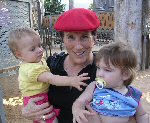
The Human Spirit: Sparks in Africa, part II
February 2, 2006
In a hospital clinic in Gondar, Ethiopia, a cherubic three-year-old with big brown eyes sits quietly on his aunt's lap. Dr. Sissay Anberbir, a skilled senior pediatrician, explains his case to the visiting Israeli doctors. The boy's father died before he was born, his mother when he was five months old. Since then, this aunt has taken care of him, watching and waiting, terrified as the sand in the hourglass relentlessly runs out for him, too.
Like his parents and an estimated 600,000 persons in the Amhara region of Northern Ethiopia, the boy is HIV positive. Born with what the Ethiopians call "the new disease," his death was certain until a short while ago. But now there's hope. In his case, hope comes partly because of the Israelis.
The flight from Addis Ababa to Gondar takes an hour, flying over Lake Tana. The pilot points out the famous source of the Blue Nile. Among those flying north are physicians and professors at Gondar's highly esteemed medical school and its newly inaugurated university. Others are tourists, drawn by the 17th-century palace in a city where small herds of cattle and goats share the dusty roads with jitneys. There are no ATMs and the hotel doesn't accept credit cards. The name Gondar is familiar to Israelis from stories of the Jewish communities that immigrated from the villages around it. But today's visit has nothing to do with Jewish immigration. The Israelis have come to Gondar to contribute to the battle against the AIDS pandemic in Africa.
A SINGLE ambulance services the 350-bed hospital. Gravely ill patients, many with AIDS, are carried by relatives or porters on improvised wire stretchers to wards crowded with coughing tubercular patients. The expensive drugs needed to create the so-called "cocktail" of anti-viral therapy, ART, are now provided by the US. Nonetheless, Dr. Sissay had been reluctant to begin treatment for children, considering their early deaths inevitable. To survive, this parentless three-year-old would have to receive a fine-tuned pharmaceutical cocktail twice a day, forever. Incomplete treatment would do more harm than good.
But then Dr. Sissay joined a group of medical professionals from Ethiopia who visited Israel. There they met pediatric AIDS patients, some from African families, treated for over a decade. He saw how nurses, social workers, community workers and volunteers played a role in making sure medications are taken. He was convinced it could be done in Africa.
Physicians Shlomo Ma'ayan, who heads the project, and Dan Engelhard are from Hadassah-University Hospital in Jerusalem. Dan Turner directs the AIDS Center at Tel Aviv Medical Center, and Dr. Zahava Grossman the AIDS reference laboratory at Sheba Medical Center in Tel Hashomer. They're "the Israeli AIDS Consortium," subcontractors for a huge AIDS-fighting project of the University of Washington in Seattle, with funds and supplies coming from the American Center for Disease Control.
Respectful and observant, unfazed by postponed internal flights or inelegant accommodations, the members of the Israeli AIDS consortium carry on constant discussions on how to best adapt the program. They're all middle-aged, and unlike many colleagues in the West, their professional skills were honed in times of austerity and less-than-ideal budgetary realities. Their Middle Eastern patients have presented a wide range of cultural challenges. They have an irrepressible desire to use everything they've learned from books and experience to help. The Ethiopian hosts make their high expectations clear: they aim at creating a center of excellence that will serve as a model for all Africa, and they need the Israelis' hands-on help for this.
RUMORS THAT there might indeed be something she can do for her nephew have brought the three-year-old's aunt to the hospital despite the terrible social stigma of being associated with AIDS. The Israeli doctors join the examination, and find lymph nodes enlarged all over his body, a sign of AIDS. They discuss the appropriate antiviral drugs. Correct treatment depends on lab measurements, particularly lymphocytes and viral load. Dr. Grossman has already volunteered to personally help organize an expanded laboratory to get the flow of sample testing just right. Drug resistance also needs to be measured.
Many more patients wait on wooden benches outside the clinic. The battle is just beginning. The numbers experts quote are staggering. There are over 700,000 AIDS orphans in Ethiopia, more than 12 million in sub-Saharan Africa. But numbers are hard to relate to. The next patient enters. Also three, he's wearing gray corduroy overalls. He, too, arrives with his adoptive aunt. After six months of treatment for TB, he can now begin his ART. A nurse records conclusions in an oversized ledger. The third patient, six, comes with his mother, a soft-spoken woman modestly dressed in a lime-green dress and head scarf. She's also HIV-positive. Both will receive ART.
For the first time, sitting in this room, the idea of treating the tens of millions of Africans with AIDS seems possible. Just as we Israelis were the first to welcome boat people, rescue those trapped under foreign rubble, or are among the first ready with field hospitals in disaster areas, I'm proud of the role these beautiful Israelis are playing. I finger the Star of David on my neck and think of the daily prayer letaken olam b'malchut shadai, the command to perfect the world through the Almighty's sovereignty as made manifest by our efforts.
It's happening before my eyes in Gondar.
